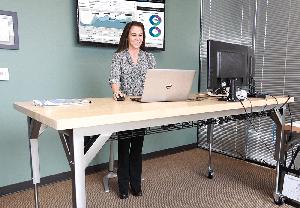Is Sitting is the New Smoking — 7 Steps to a Healthier Workforce
Sitting is the new smoking for office employees. Formaspace CEO, Jeff Turk, gives 7 tips for a healthier workforce! Read them here.
It’s no secret that healthcare costs are out of control. In fact, when I attend CEO roundtables or talk to clients who are business owners, healthcare costs are always one of their biggest concerns. Lots of CEOs I know have attacked smoking with cessation programs, built kitchens in their offices to encourage healthy eating, and added wellness programs to attack obesity in their workplaces. Yet most companies still haven’t taken some of the easiest steps to attract and retain great people while simultaneously improving the health and productivity of their workforce.
What factors are driving up the cost of medical care and pushing down worker productivity?
Here are three examples:
Lower back pain now affects more than 100 million Americans— more than those with heart disease, diabetes, and cancer combined — according to Stanford University Medical Center’s Professor Sean Mackey, MD1. According to the World Health Organization, American companies lose 149 million work days per year to lower back pain, at a cost of $100-200 billion annually.
Sitting for prolonged periods of time increases the risk for heart disease, diabetes, cancer, and death, regardless of whether a person exercises regularly or not, according to a study published by David Alter, MD, Ph.D. in the Annals of Internal Medicine. Despite what you might think, exercising for one hour a day doesn’t eliminate the health problems caused by prolonged sitting.
Sleep deprivation affects between 50 and 70 million Americans. According to Ronald C. Kessler, Ph.D. at Harvard Medical School, the economic cost of insomnia is between $15 billion and $92 billion annually.
WHAT CAN BE DONE ABOUT IT? HERE ARE 7 ACTION STEPS YOU CAN TAKE NOW.
Step 1. Move.
Visionaries like Tom Rath, author of several New York Times bestselling books, including Eat Move Sleep: How Small Choices Lead to Big Changes, have been right on the money when they say we need to move.
In a recent podcast interview2, Rath said, “Sitting is the most underrated health threat of the modern era.”
“What we don’t realize, because it’s happened even more slowly than the epidemic of smoking (is) we’ve subtly worked activity out of our daily routine. 50 years ago … you had to be moving around and keep active; now we’ve got it all engineered so we can sit at a computer and order everything on Amazon, so it shows up at our front door and (we) drive around in circles so we don’t have to take a hundred steps at the shopping mall parking lot and so forth. And so we’ve done it piece-by-piece over time. We don’t realize that most people end up sitting for eight to ten hours a day on average.”
Step one in improving workforce productivity is to encourage people to stand and move!
Step 2. Get Sit-to-Stand Desks.
In the study on the risks of sitting for prolonged periods of time mentioned above, author David Alter, MD, Ph.D., had this advice:
Every thirty minutes, you should take a short (1-3 minute) break and stand up. Standing burns twice as many calories as sitting.
Gradually change your behavior. Initially, try reducing your sitting times by 15 – 20 minutes per day. Reduce sitting week by week. Over the long term, you should try to eliminate 2 to 3 hours of sitting during a 12 hour day.
Other studies, like one from Stanford University (“Impact of a Sit-Stand Workstation on Chronic Lower Back Pain Results of a Randomized Trial”) published in the Journal of Occupational and Environmental Medicine, found office workers who used standing desks experienced less pain while working. Importantly, those who came into the study with lower back and neck pain reported a reduction in pain and an increase in their ability to concentrate on work tasks when using sit-to-stand desks.
Step two, in short, is to equip your people with sit to stand desks to encourage movement!
Step 3. Sleep.
Tom Rath compares losing four hours of sleep to drinking a six-pack of beer. “When I get on an airplane next week, I don’t want the pilot to have the equivalent of a six-pack (of beer) in his system!” Rath continues: “Every extra hour of sleep is really an investment in your future productivity and happiness, not the first thing we should be cutting when we get busy and have a lot of things going on.”
Getting a good night of sleep is important, and it starts with proper ‘sleep hygiene’ like making the room dark.
You may have taken notice of Apple’s recent introduction of “Night Shift,” which alters the color of their smartphone and tablet devices — changing their hue from a blue light to more reddish tones. Why? Blue light tells our biological clock that the sun is rising, making it hard for us to fall asleep.
Just this month, the American Medical Association echoed this sentiment by issuing their first-ever guidance on the harmful effects of increasingly popular high-intensity, blue-rich LED street lights3. According to the AMA, blue LED lights can create a road hazard by decreasing our visual acuity. They also suppress melatonin at night, interfering with sleep. According to the guidance: “Recent large surveys found that brighter residential nighttime lighting is associated with reduced sleep times, dissatisfaction with sleep quality, excessive sleepiness, impaired daytime functioning, and obesity.”
My advice? Make a nice dark room and get some sleep.
Step 4: You have a mobile device. Use it!
Has it ever occurred to you just how ironic the rise of sedentary work habits at the office is?
When I was a kid, I typed out missives on an IBM Selectric typewriter. Later, I got a Tandem 1000 computer. Either way, if I wanted to write something, I had to sit hunched over for long periods. Today, everyone has speech-to-text on their phones. There is no need to sit, but old habits die hard.
Step four is to leverage your technology to create a healthier lifestyle.
Step 5: Lead from the front.
Tom Rath has another point about how employers are mishandling the opportunity to influence their workers to make better, healthier choices. In Rath’s words, is there anything less appealing than the sound of things like “Disease Management Programs” or “Heath Risk Appraisals”?
Rising healthcare costs are a major concern for employers, but implementing “punitive” programs that focus on the negatives (like asking employees to pay healthcare surcharges if they don’t meet the employer’s health guidelines) are not as effective as programs that promote positive changes in employee behavior.
According to Rath, it’s very difficult for people to do things today that will benefit themselves decades from now. But they will follow their leader, at least a little bit. If you stand, if you move, and if they see you leading an active lifestyle, they will too.
Read more ... https://formaspace.com/articles/formaspace-news/sitting-is-the-new-smoking/?utm_source=facebook&utm_source=einpresswire&utm_medium=social&utm_medium=content&utm_campaign=article-101816
Brooke Turner
Formaspace
8002511505
email us here
1 http://www.shlnews.org/?p=803
2 https://blog.octanner.com/culture/gwi033-tom-rath
3 https://www.ama-assn.org/ama-adopts-guidance-reduce-harm-high-intensity-street-lights



